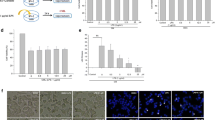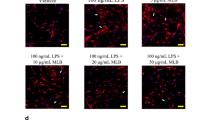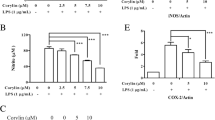Abstract
Neuroinflammation is a major factor in the pathogenesis of various neurodegenerative diseases. Microglia are resident macrophages that act as key mediators of inflammation in the brain. In response to inflammatory stimuli including lipopolysaccharide (LPS), microglial activation occurs immediately. Overproduction of inflammatory mediators released by activated microglia contributes to neuron damage in neurodegenerative disease. Therefore, identification of a compound that has anti-inflammatory activities and inhibits microglial activation may be an alternative therapeutic approach for the treatment of neurodegenerative diseases. Cyanidin-3-O-glucoside (C3G), a type of anthocyanin, possesses powerful anti-inflammatory activities. In this study, the anti-inflammatory effects of C3G were investigated in LPS-stimulated BV2 microglia. The results indicate that pretreatment with C3G significantly suppresses microglial activation and the production of neurotoxic mediators including nitric oxide (NO), prostaglandin E2 (PGE2), and pro-inflammatory cytokines such as interleukin-1β (IL-1β) and interleukin-6 (IL-6) in LPS-activated BV2 cells. Moreover, C3G downregulates the gene expressions of inducible nitric oxide synthase (iNOS), cyclooxygenase-2 (COX-2), and pro-inflammatory cytokines via the suppression of NF-κB and p38 MAPK signaling pathways. Furthermore, a co-culture system to determine the indirect neuroprotective effects of C3G was used. Results demonstrated that conditioned medium (CM) from LPS-stimulated BV2 cells can promote the apoptosis of differentiated pheochromocytoma (PC12) cells through the activation of caspase-3, while C3G pretreatment in BV2 microglia can protect differentiated PC12 cells from microglial activation-induced apoptosis. Therefore, C3G may be a potential therapeutic agent for the treatment and prevention of neurodegenerative diseases associated with microglial activation.








Similar content being viewed by others
References
Andrea Tarozzi, Fabiana Morroni, Adriana Merlicco, Cecilia Bolondi, Gabriella Teti, Mirella Falconi, Giorgio Cantelli-Forti, Patrizia Hrelia, (2010) Neuroprotective effects of cyanidin 3-O-glucopyranoside on amyloid beta (25–35) oligomer-induced toxicity. Neuroscience Letters 473 (2):72-76
Andreasson K (2010) Emerging roles of PGE2 receptors in models of neurological disease. Prostaglandins Other Lipid Mediat 91:104–112. https://doi.org/10.1016/j.prostaglandins.2009.04.003
Andres-Lacueva C, Shukitt-Hale B, Galli RL, Jauregui O, Lamuela-Raventos RM, Joseph JA (2005) Anthocyanins in aged blueberry-fed rats are found centrally and may enhance memory. Nutr Neurosci 8:111–120. https://doi.org/10.1080/10284150500078117
Bi W, Zhu L, Jing X, Zeng Z, Liang Y et al (2014) Rifampicin improves neuronal apoptosis in LPS-stimulated cocultured BV2 cells through inhibition of the TLR-4 pathway. Mol Med Rep 10:1793–1799. https://doi.org/10.3892/mmr.2014.2480
Block ML, Zecca L, Hong JS (2007) Microglia-mediated neurotoxicity: uncovering the molecular mechanisms. Nat Rev Neurosci 8:57–69. https://doi.org/10.1038/nrn2038
Bozic I, Savic D, Laketa D, Bjelobaba I, Milenkovic I et al (2015) Benfotiamine attenuates inflammatory response in LPS stimulated BV-2 microglia. PLoS One 10:e0118372. https://doi.org/10.1371/journal.pone.0118372
Brown GC, Bal-Price A (2003) Inflammatory neurodegeneration mediated by nitric oxide, glutamate, and mitochondria. Mol Neurobiol 27:325–355. https://doi.org/10.1385/mn:27:3:325
Brown GC, Neher JJ (2010) Inflammatory neurodegeneration and mechanisms of microglial killing of neurons. Mol Neurobiol 41:242–247. https://doi.org/10.1007/s12035-010-8105-9
Chen G, Bower KA, Xu M, Ding M, Shi X, Ke ZJ, Luo J (2009) Cyanidin-3-glucoside reverses ethanol-induced inhibition of neurite outgrowth: role of glycogen synthase kinase 3. Beta Neurotox Res 15:321–331. https://doi.org/10.1007/s12640-009-9036-y
Czank C, Cassidy A, Zhang Q, Morrison DJ, Preston T et al (2013) Human metabolism and elimination of the anthocyanin, cyanidin-3-glucoside: a (13)C-tracer study. Am J Clin Nutr 97:995–1003. https://doi.org/10.3945/ajcn.112.049247
D’Amelio M, Sheng M, Cecconi F (2012) Caspase-3 in the central nervous system: beyond apoptosis. Trends Neurosci 35:700–709. https://doi.org/10.1016/j.tins.2012.06.004
Dai J-N, Zong Y, Zhong LM, Li YM, Zhang WB et al (2011) Gastrodin inhibits expression of inducible NO synthase, cyclooxygenase-2 and proinflammatory cytokines in cultured LPS-stimulated microglia via MAPK pathways. PLoS One 6:e21891. https://doi.org/10.1371/journal.pone.0021891
Dai XJ, Li N, Yu L, Chen ZY, Hua R, Qin X, Zhang YM (2015) Activation of BV2 microglia by lipopolysaccharide triggers an inflammatory reaction in PC12 cell apoptosis through a toll-like receptor 4-dependent pathway. Cell Stress Chaperones 20:321–331. https://doi.org/10.1007/s12192-014-0552-1
Davinelli S, Maes M, Corbi G, Zarrelli A, Willcox DC, Scapagnini G (2016) Dietary phytochemicals and neuro-inflammaging: from mechanistic insights to translational challenges. Immun Ageing 13:16. https://doi.org/10.1186/s12979-016-0070-3
Davis BM, Salinas-Navarro M, Cordeiro MF, Moons L, De Groef L et al (2017) Characterizing microglia activation: a spatial statistics approach to maximize information extraction. Sci Rep 7:1576. https://doi.org/10.1038/s41598-017-01747-8
Dec E, Rana P, Katheria V, Dec R, Khare M (2014) Cytokine profiling in patients with VCP-associated disease Clinical and translational science 7:29-32 https://doi.org/10.1111/cts.12117
Doherty GH (2011) Nitric oxide in neurodegeneration: potential benefits of non-steroidal anti-inflammatories. Neurosci Bull 27:366–382. https://doi.org/10.1007/s12264-011-1530-6
Durães F, Pinto M, Sousa E (2018) Old drugs as new treatments for neurodegenerative diseases. Pharmaceuticals 11. https://doi.org/10.3390/ph11020044
Eric Dec, Prachi Rana, Veeral Katheria, Rachel Dec, Manaswitha Khare, Angèle Nalbandian, Szu-Yun Leu, Shlomit Radom-Aizik, Katrina Llewellyn, Lbachir BenMohamed, Frank Zaldivar, Virginia Kimonis, (2014) Cytokine Profiling in Patients with VCP-Associated Disease. Clinical and Translational Science 7 (1):29-32
Erkkinen MG, Kim MO, Geschwind MD (2018) Clinical neurology and epidemiology of the major neurodegenerative diseases. Cold Spring Harb Perspect Biol 10. https://doi.org/10.1101/cshperspect.a033118
Ferrars R, Czank C, Zhang Q, Botting N, Kroon P, Cassidy A, Kay C (2014) The pharmacokinetics of anthocyanins and their metabolites in humans. Br J Pharmacol 171:3268–3282
Fornasaro S, Ziberna L, Gasperotti M, Tramer F, Vrhovšek U, Mattivi F, Passamonti S (2016) Determination of cyanidin 3-glucoside in rat brain, liver and kidneys by UPLC/MS-MS and its application to a short-term pharmacokinetic study. Sci Rep 6:22815. https://doi.org/10.1038/srep22815 https://www.nature.com/articles/srep22815#supplementary-information Accessed 19 Aug 2018
Gao HM, Hong JS (2008) Why neurodegenerative diseases are progressive: uncontrolled inflammation drives disease progression. Trends Immunol 29:357–365. https://doi.org/10.1016/j.it.2008.05.002
Gibbons HM, Dragunow M (2006) Microglia induce neural cell death via a proximity-dependent mechanism involving nitric oxide. Brain Res 1084:1–15. https://doi.org/10.1016/j.brainres.2006.02.032
He Q, Wang Y, Lin W, Zhang Q, Zhao J et al (2014) Trehalose alleviates PC12 neuronal death mediated by lipopolysaccharide-stimulated BV-2 cells via inhibiting nuclear transcription factor NF-kappaB and AP-1 activation. Neurotox Res 26:430–439. https://doi.org/10.1007/s12640-014-9487-7
Heneka MT, Kummer MP, Latz E (2014) Innate immune activation in neurodegenerative disease. Nat Rev Immunol 14:463–477. https://doi.org/10.1038/nri3705
Hughes V (2012) Microglia: the constant gardeners. Nature 485:570–572. https://doi.org/10.1038/485570a
Jeong JW, Lee WS, Shin SC, Kim GY, Choi BT, Choi YH (2013) Anthocyanins downregulate lipopolysaccharide-induced inflammatory responses in BV2 microglial cells by suppressing the NF-kappaB and Akt/MAPKs signaling pathways. Int J Mol Sci 14:1502–1515. https://doi.org/10.3390/ijms14011502
Jung HW, Yoon CH, Park KM, Han HS, Park YK (2009) Hexane fraction of Zingiberis Rhizoma Crudus extract inhibits the production of nitric oxide and proinflammatory cytokines in LPS-stimulated BV2 microglial cells via the NF-kappaB pathway. Food Chem Toxicol 47:1190–1197. https://doi.org/10.1016/j.fct.2009.02.012
Kang TH, Hur JY, Kim HB, Ryu JH, Kim SY (2006) Neuroprotective effects of the cyanidin-3-O-beta-d-glucopyranoside isolated from mulberry fruit against cerebral ischemia Neurosci Lett 391:122-126 https://doi.org/10.1016/j.neulet.2005.08.053
Kaminska B (2005) MAPK signalling pathways as molecular targets for anti-inflammatory therapy—from molecular mechanisms to therapeutic benefits. Biochim Biophys Acta Protein Proteom 1754:253–262. https://doi.org/10.1016/j.bbapap.2005.08.017
Ke Z, Liu Y, Wang X, Fan Z, Chen G (2011) Cyanidin-3-glucoside ameliorates ethanol neurotoxicity in the developing brain J Neurosci Res 89:1676-1684 https://doi.org/10.1002/jnr.22689
Kim EK, Choi EJ (2010) Pathological roles of MAPK signaling pathways in human diseases. Biochim Biophys Acta 1802:396–405. https://doi.org/10.1016/j.bbadis.2009.12.009
Kim SH, Smith CJ, Van Eldik LJ (2004) Importance of MAPK pathways for microglial pro-inflammatory cytokine IL-1 beta production. Neurobiol Aging 25:431–439. https://doi.org/10.1016/s0197-4580(03)00126-x
Korotkova M et al (2005) Effects of antirheumatic treatments on the prostaglandin E2 biosynthetic pathway. Arthritis Rheum 52:3439–3447. https://doi.org/10.1002/art.21390
Kuno R, Wang J, Kawanokuchi J, Takeuchi H, Mizuno T, Suzumura A (2005) Autocrine activation of microglia by tumor necrosis factor-alpha. J Neuroimmunol 162:89–96. https://doi.org/10.1016/j.jneuroim.2005.01.015
Lan X, Liu R, Sun L, Zhang T, Du G (2011) Methyl salicylate 2-O-beta-D-lactoside, a novel salicylic acid analogue, acts as an anti-inflammatory agent on microglia and astrocytes. J Neuroinflammation 8:98. https://doi.org/10.1186/1742-2094-8-98
Libro R, Giacoppo S, Soundara Rajan T, Bramanti P, Mazzon E et al (2016) Natural phytochemicals in the treatment and prevention of dementia: an overview. Molecules (Basel) 21:518. https://doi.org/10.3390/molecules21040518
Livak KJ, Schmittgen TD (2001) Analysis of relative gene expression data using real-time quantitative PCR and the 2−ΔΔCT method. Methods 25:402–408. https://doi.org/10.1006/meth.2001.1262
Lull ME, Block ML (2010) Microglial activation and chronic neurodegeneration. Neurotherapeutics 7:354–365. https://doi.org/10.1016/j.nurt.2010.05.014
Min SW, Ryu SN, Kim DH (2010) Anti-inflammatory effects of black rice, cyanidin-3-O-beta-D-glycoside, and its metabolites, cyanidin and protocatechuic acid. Int Immunopharmacol 10:959–966
Minghetti L (2005) Role of inflammation in neurodegenerative diseases. Curr Opin Neurol 18:315–321
Ock J, Han HS, Hong SH, Lee SY, Han YM, Kwon BM, Suk K (2010) Obovatol attenuates microglia-mediated neuroinflammation by modulating redox regulation. Br J Pharmacol 159:1646–1662
Ohshima H, Bartsch H (1994) Chronic infections and inflammatory processes as cancer risk factors: possible role of nitric oxide in carcinogenesis. Mutat Res 305:253–264
Pautz A, Art J, Hahn S, Nowag S, Voss C, Kleinert H (2010) Regulation of the expression of inducible nitric oxide synthase. Nitric Oxide Biol Chem 23:75–93. https://doi.org/10.1016/j.niox.2010.04.007
Perry VH, Nicoll JA, Holmes C (2010) Microglia in neurodegenerative disease. Nat Rev Neurol 6:193–201. https://doi.org/10.1038/nrneurol.2010.17
Qin L, Li G, Qian X, Liu Y, Wu X et al (2005) Interactive role of the toll-like receptor 4 and reactive oxygen species in LPS-induced microglia activation. Glia 52:78–84. https://doi.org/10.1002/glia.20225
Qin L, Zhang J, Qin M (2013) Protective effect of cyanidin 3-O-glucoside on beta-amyloid peptide-induced cognitive impairment in rats. Neurosci Lett 534:285–288. https://doi.org/10.1016/j.neulet.2012.12.023
Ricciotti E, FitzGerald GA (2011) Prostaglandins and inflammation. Arterioscler Thromb Vasc Biol 31:986–1000. https://doi.org/10.1161/atvbaha.110.207449
Rock RB, Peterson PK (2006) Microglia as a pharmacological target in infectious and inflammatory diseases of the brain. J NeuroImmune Pharmacol 1:117–126. https://doi.org/10.1007/s11481-006-9012-8
Saha RN, Pahan K (2006) Regulation of inducible nitric oxide synthase gene in glial cells. Antioxid Redox Signal 8:929–947. https://doi.org/10.1089/ars.2006.8.929
Sawada M, Kondo N, Suzumura A, Marunouchi T (1989) Production of tumor necrosis factor-alpha by microglia and astrocytes in culture. Brain Res 491:394–397
Shin WH, Park SJ, Kim EJ (2006) Protective effect of anthocyanins in middle cerebral artery occlusion and reperfusion model of cerebral ischemia in rats Life sciences 79:130-137 https://doi.org/10.1016/j.lfs.2005.12.033
Shi X, Zheng Z, Li J, Xiao Z, Qi W et al (2015) Curcumin inhibits Aβ-induced microglial inflammatory responses in vitro: involvement of ERK1/2 and p38 signaling pathways. Neurosci Lett 594:105–110. https://doi.org/10.1016/j.neulet.2015.03.045
Shie FS, Chen YH, Chen CH, Ho IK (2011) Neuroimmune pharmacology of neurodegenerative and mental diseases. J NeuroImmune Pharmacol 6:28–40. https://doi.org/10.1007/s11481-010-9241-8
Sil S, Ghosh T, Ghosh R, Gupta P (2017) Nitric oxide synthase inhibitor, aminoguanidine reduces intracerebroventricular colchicine induced neurodegeneration, memory impairments and changes of systemic immune responses in rats. J Neuroimmunol 303:51–61. https://doi.org/10.1016/j.jneuroim.2016.12.007
Song XY, Hu JF, Sun MN, Li ZP, Zhu ZX et al (2014) IMM-H004, a novel coumarin derivative compound, attenuates the production of inflammatory mediatory mediators in lipopolysaccharide-activated BV2 microglia. Brain Res Bull 106:30–38. https://doi.org/10.1016/j.brainresbull.2014.05.002
Tak PP, Firestein GS (2001) NF-κB: a key role in inflammatory diseases. J Clin Invest 107:7–11. https://doi.org/10.1172/JCI11830
Talavera S, Felgines C, Texier O, Besson C, Gil-Izquierdo A, Lamaison JL, Remesy C (2005) Anthocyanin metabolism in rats and their distribution to digestive area, kidney, and brain. J Agric Food Chem 53:3902–3908. https://doi.org/10.1021/jf050145v
Tarozzi A, Morroni F, Hrelia S, Angeloni C, Marchesi A, Cantelli-Forti G, Hrelia P (2007) Neuroprotective effects of anthocyanins and their in vivo metabolites in SH-SY5Y cells. Neurosci Lett 424:36–40. https://doi.org/10.1016/j.neulet.2007.07.017
Tarozzi A, Morroni F, Merlicco A, Bolondi C, Teti G (2010) Neuroprotective effects of cyanidin 3-O-glucopyranoside on amyloid beta (25-35) oligomerinduced toxicity Neurosci Lett 473:72-76 https://doi.org/10.1016/j.neulet.2010.02.006
Tarozzi A, Merlicco A, Morroni F, Franco F, Cantelli-Forti G, Teti G, Falconi M, Hrelia P (2008) Cyanidin 3-O-glucopyranoside protects and rescues SH-SY5Y cells against amyloid-beta peptide-induced toxicity. Neuroreport 19:1483–1486. https://doi.org/10.1097/WNR.0b013e32830fe4b8
Tong Ho Kang, Jin Young Hur, Hyun Bok Kim, Jong Hoon Ryu, Sun Yeou Kim, (2006) Neuroprotective effects of the cyanidin-3-O-β-d-glucopyranoside isolated from mulberry fruit against cerebral ischemia. Neuroscience Letters 391 (3):122-126
Won-Ho Shin, Sang-Joon Park, Eun-Joo Kim, (2006) Protective effect of anthocyanins in middle cerebral artery occlusion and reperfusion model of cerebral ischemia in rats. Life Sciences 79 (2):130-137
Udomruk S, Kaewmool C, Pothacharoen P, Phitak T, Kongtawelert P (2018) Sesamin suppresses LPS-induced microglial activation via regulation of TLR4 expression. J Funct Foods 49:32–43. https://doi.org/10.1016/j.jff.2018.08.020
Wu WY, Wu YY, Huang H, He C, Li WZ et al (2015) Biochanin a attenuates LPS-induced pro-inflammatory responses and inhibits the activation of the MAPK pathway in BV2 microglial cells. Int J Mol Med 35:391–398. https://doi.org/10.3892/ijmm.2014.2020
Xu R, Liu J, Chen X, Xu F, Xie Q et al (2001) Ribozyme-mediated inhibition of caspase-3 activity reduces apoptosis induced by 6-hydroxydopamine in PC12 cells. Brain Res 899:10–19
Xu YQ, Long L, Yan JQ, Wei L, Pan MQ et al (2013) Simvastatin induces neuroprotection in 6-OHDA-lesioned PC12 via the PI3K/AKT/caspase 3 pathway and anti-inflammatory responses. CNS Neurosci Ther 19:170–177. https://doi.org/10.1111/cns.12053
Xu J, Yuan C, Wang G, Luo J, Ma H, Xu L, Mu Y, Li Y, Seeram NP, Huang X, Li L (2018) Urolithins attenuate LPS-induced neuroinflammation in BV2Microglia via MAPK, Akt, and NF-kappaB signaling pathways. J Agric Food Chem 66:571–580. https://doi.org/10.1021/acs.jafc.7b03285
Ye J, Liu Z, Wei J, Lu L, Huang Y, Luo L, Xie H (2013) Protective effect of SIRT1 on toxicity of microglial-derived factors induced by LPS to PC12 cells via the p53-caspase-3-dependent apoptotic pathway. Neurosci Lett 553:72–77. https://doi.org/10.1016/j.neulet.2013.08.020
Zhang Y, Lian F, Zhu Y, Xia M, Wang Q, Ling W, Wang XD (2010) Cyanidin-3-O-beta-glucoside inhibits LPS-induced expression of inflammatory mediators through decreasing IkappaBalpha phosphorylation in THP-1 cells. Inflamm Res 59:723–730. https://doi.org/10.1007/s00011-010-0183-7
Zhong LM, Zong Y, Sun L, Guo JZ, Zhang W, He Y, Song R, Wang WM, Xiao CJ, Lu D (2012) Resveratrol inhibits inflammatory responses via the mammalian target of rapamycin signaling pathway in cultured lps-stimulated microglial cells. PLoS One 7:e32195. https://doi.org/10.1371/journal.pone.0032195
Zunji Ke, Ying Liu, Xin Wang, Zhiqin Fan, Gang Chen, Mei Xu, Kimberley A. Bower, Jacqueline A. Frank, Xiaoming Ou, Xianglin Shi, Jia Luo, (2011) Cyanidin-3-glucoside ameliorates ethanol neurotoxicity in the developing brain. Journal of Neuroscience Research 89 (10):1676-1684
Funding
This study was funded by 50th Anniversary Chiang Mai University research fund for Chayanut Kaewmool (PHD/018/2557).
Author information
Authors and Affiliations
Corresponding author
Ethics declarations
Conflict of Interest
The authors declare that they have no conflict of interest.
Additional information
Publisher’s Note
Springer Nature remains neutral with regard to jurisdictional claims in published maps and institutional affiliations.
Rights and permissions
About this article
Cite this article
Kaewmool, C., Udomruk, S., Phitak, T. et al. Cyanidin-3-O-Glucoside Protects PC12 Cells Against Neuronal Apoptosis Mediated by LPS-Stimulated BV2 Microglial Activation. Neurotox Res 37, 111–125 (2020). https://doi.org/10.1007/s12640-019-00102-1
Received:
Revised:
Accepted:
Published:
Issue Date:
DOI: https://doi.org/10.1007/s12640-019-00102-1




